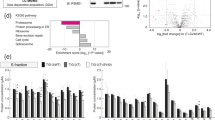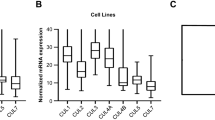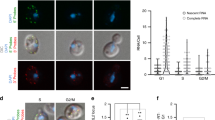Abstract
ERM is a member of the ETS transcription factor family. High levels of the corresponding mRNA are detected in a variety of human breast cancer cell lines, as well as in aggressive human breast tumors. As ERM protein is almost undetectable in these cells, high degradation of this transcription factor has been postulated. Here we have investigated whether ERM degradation might depend on the proteasome pathway. We show that endogenous and ectopically expressed ERM protein is short-lived protein and undergoes proteasome-dependent degradation. Deletion mutagenesis studies indicate that the 61 C-terminal amino acids of ERM are critical for its proteolysis and serve as a degradation signal. Although ERM conjugates with ubiquitin, this post-translational modification does not depend on the C-terminal domain. We have used an Ets-responsive ICAM-1 reporter plasmid to show that the ubiquitin–proteasome pathway can affect transcriptional function of ERM. Thus, ERM is subject to degradation via the 26S proteasome pathway, and this pathway probably plays an important role in regulating ERM transcriptional activity.
This is a preview of subscription content, access via your institution
Access options
Subscribe to this journal
Receive 50 print issues and online access
$259.00 per year
only $5.18 per issue
Buy this article
- Purchase on Springer Link
- Instant access to full article PDF
Prices may be subject to local taxes which are calculated during checkout








Similar content being viewed by others
References
Alvarez-Castelao B, Castano JG . (2005). FEBS Lett 579: 4797–4802.
Baert JL, Beaudoin C, Coutte L, de Launoit Y . (2002). J Biol Chem 277: 1002–1012.
Baert JL, Monte D, Musgrove EA, Albagli O, Sutherland RL, de Launoit Y . (1997). Int J Cancer 70: 590–597.
Blanquart C, Barbier O, Fruchart JC, Staels B, Glineur C . (2002). J Biol Chem 277: 37254–37259.
Bres V, Kiernan RE, Linares LK, Chable-Bessia C, Plechakova O, Treand C et al. (2003). Nat Cell Biol 5: 754–761.
Chotteau-Lelièvre A, Desbiens X, Pelczar H, Defossez PA, de Launoit Y . (1997). Oncogene 15: 937–952.
Chotteau-Lelièvre A, Dolle P, Peronne V, Coutte L, de Launoit Y, Desbiens X . (2001). Mech Dev 108: 191–195.
Chotteau-Lelièvre A, Montesano R, Soriano JV, Soulie P, Desbiens X, de Launoit Y . (2003). Dev Biol 259: 241–257.
Chotteau Lelièvre A, Révillion F, Lhotellier V, Hornez L, Desbiens X, Cabaret V et al. (2004). Clin Cancer Res 19: 7297–7303.
Ciechanover A, Orian A, Schwartz AL . (2000). BioEssays 22: 442–451.
Conaway RC, Brower CS, Conaway JW . (2002). Science 296: 1254–1258.
Dalton WS . (2004). Semin Oncol 31: 3–9; discussion 33.
de Launoit Y, Audette M, Pelczar H, Plaza S, Baert JL . (1998). Oncogene 16: 2065–2073.
Defossez PA, Baert JL, Monnot M, de Launoit Y . (1997). Nucleic Acids Res 25: 4455–4463.
Degerny C, Monté D, Beaudoin C, Jaffray E, Portois L, Hay RT et al. (2005). J Biol Chem 280: 24330–24338.
Deroo BJ, Rentsch C, Sampath S, Young J, DeFranco DB, Archer TK . (2002). Mol Cell Biol 22: 4113–4123.
Galang CK, Muller WJ, Foos G, Oshima RG, Hauser CA . (2004). J Biol Chem 279: 11281–11292.
Goel A, Janknecht R . (2003). Mol Cell Biol 23: 6243–6254.
Greer SF, Zika E, Conti B, Zhu XS, Ting JP . (2003). Nat Immunol 4: 1074–1082.
Janknecht R, Monte D, Baert JL, de Launoit Y . (1996). Oncogene 13: 1745–1754.
Kurosu T, Peterlin BM . (2004). Curr Biol 14: 1112–1116.
Laget MP, Defossez PA, Albagli O, Baert JL, Dewitte F, Stehelin D et al. (1996). Oncogene 12: 1325–1336.
Laney JD, Hochstrasser M . (1999). Cell 97: 427–430.
Lipford JR, Deshaies RJ . (2003). Nat Cell Biol 5: 845–850.
Maurer P, T’Sas F, Coutte L, Callens N, Brenner C, Van Lint C et al. (2003). Oncogene 22: 3319–3329.
Molinari E, Gilman M, Natesan S . (1999). EMBO J 18: 6439–6447.
Murakami Y, Matsufuji S, Hayashi SI, Tanahashi N, Tanaka K . (1999). Mol Cell Biol 19: 7216–7227.
Muratani M, Kung C, Shokat KM, Tansey WP . (2005). Cell 120: 887–899.
Muratani M, Tansey WP . (2003). Nat Rev Mol Cell Biol 4: 192–201.
Peloponese Jr JM, Iha H, Yedavalli VR, Miyazato A, Li Y, Haller K et al. (2004). J Virol 78: 11686–11695.
Pickart CM . (2001). Annu Rev Biochem 70: 503–533.
Pickart CM . (2004). Cell 116: 181–190.
Pollenz RS . (2002). Chem Biol Interact 141: 41–61.
Prakash S, Tian L, Ratliff KS, Lehotzky RE, Matouschek A . (2004). Nat Struct Mol Biol 11: 830–837.
Salghetti SE, Caudy AA, Chenoweth JG, Tansey WP . (2001). Science 293: 1651–1653.
Salghetti SE, Muratani M, Wijnen H, Futcher B, Tansey WP . (2000). Proc Natl Acad Sci USA 97: 3118–3123.
Sharrocks AD . (2001). Nat Rev Mol Cell Biol 2: 827–837.
Shepherd TG, Kockeritz L, Szrajber MR, Muller WJ, Hassell JA . (2001). Curr Biol 11: 1739–1748.
Takahashi A, Higashino F, Aoyagi M, Yoshida K, Itoh M, Kobayashi M et al. (2005). Biochem Biophys Res Commun 327: 575–580.
Touitou R, Richardson J, Bose S, Nakanishi M, Rivett J, Allday MJ . (2001). EMBO J 20: 2367–2375.
Tworkowski KA, Salghetti SE, Tansey WP . (2002). Oncogene 21: 8515–8520.
Zhang M, Pickart CM, Coffino P . (2003). EMBO J 22: 1488–1496.
Acknowledgements
CD is supported by a PhD grant from the French Research Ministry. This work was carried out thanks to grants awarded by the ‘Centre National de la Recherche Scientifique’ (France), the ‘Institut Pasteur de Lille’, the ‘Association pour la Recherche contre le Cancer’ (France), the ‘Ligue Nationale Contre le Cancer’ (Comité Nord, France), ‘the Conseil Régional Nord/Pas-de-Calais’ (France), the European Regional Development Fund, the Interreg program ‘Intergènes’, the ‘Fonds National de la Recherche Scientifique’ (FNRS, Belgium) and the ‘Action de Recherche Concertée (Communauté Française de Belgique)’ (Belgium). CB was the recipient of a postdoctoral fellowship from the Canadian Institutes of Health Research.
Author information
Authors and Affiliations
Corresponding author
Rights and permissions
About this article
Cite this article
Baert, JL., Beaudoin, C., Monte, D. et al. The 26S proteasome system degrades the ERM transcription factor and regulates its transcription-enhancing activity. Oncogene 26, 415–424 (2007). https://doi.org/10.1038/sj.onc.1209801
Received:
Revised:
Accepted:
Published:
Issue Date:
DOI: https://doi.org/10.1038/sj.onc.1209801
Keywords
This article is cited by
-
E26 transformation-specific transcription variant 5 in development and cancer: modification, regulation and function
Journal of Biomedical Science (2023)
-
Activated ALK signals through the ERK–ETV5–RET pathway to drive neuroblastoma oncogenesis
Oncogene (2018)
-
The E3 ubiquitin ligase complex component COP1 regulates PEA3 group member stability and transcriptional activity
Oncogene (2010)
-
Transcriptome profile of Trypanosoma cruzi-infected cells: simultaneous up- and down-regulation of proliferation inhibitors and promoters
Parasitology Research (2008)



